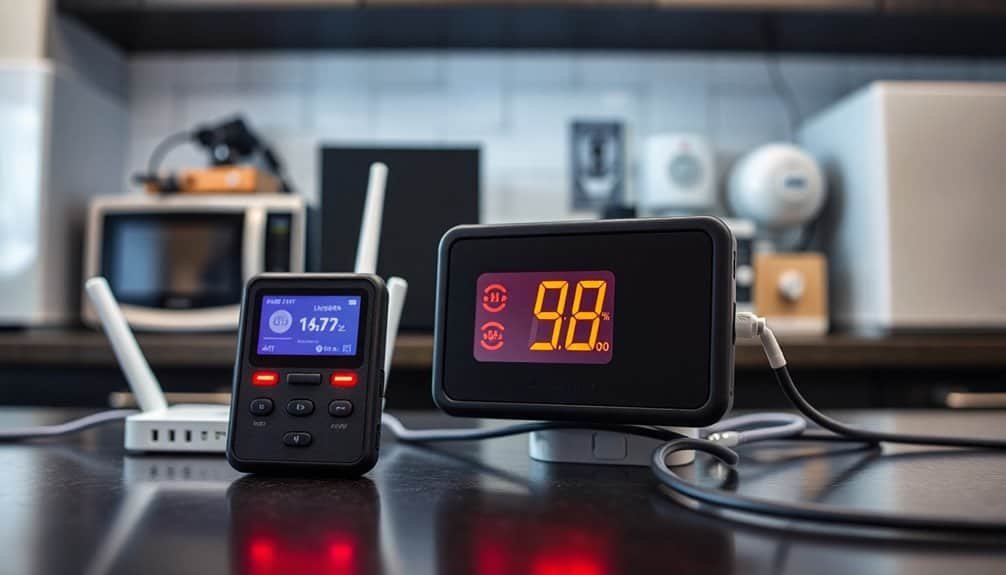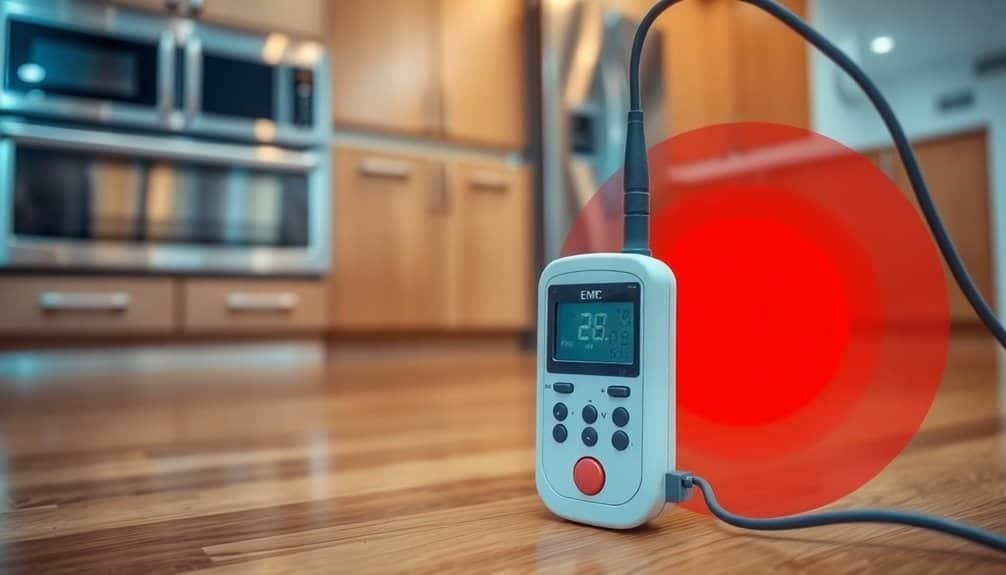Identifying High EMF Zones in Your Home
To identify high EMF zones in your home, recognize sources like cell phones, Wi-Fi routers, microwaves, and refrigerators. High EMF levels often occur near electrical meters and main distribution panels, with proximity increasing exposure risk.
Evaluate your home’s layout and device proximity to pinpoint EMF hotspots effectively. Discover strategies for managing and reducing EMF exposure for a healthier living environment.
Disclaimer: As an affiliate, I may collect a share of sales from the links on this page.
Common Sources of EMF in the Home

While you may not realize it, several devices in your home produce electromagnetic fields (EMF) that contribute to your overall exposure.
Cell phones, for instance, emit EMF through their antennas, especially when you’re holding them close to your body during calls.
Wi-Fi routers continuously emit EMF to maintain wireless connections.
Household appliances like microwaves, refrigerators, and televisions generate EMF during use, with microwaves sometimes exceeding 70 µT. In fact, most household appliances have magnetic field strengths over 100 times lower than ICNIRP reference values at typical operating distances.
Smart devices and smart meters also contribute to EMF levels.
Additionally, electrical wiring in your home produces low-frequency EMF, further increasing your overall exposure without you being aware of it.
High EMF Locations Within Your Living Space
Identifying high EMF locations in your home is essential for managing your exposure effectively.
Start by checking near electrical meters, including Smart Meters, which often register high EMF readings. Pay attention to your main distribution panel or fuse box, as these areas frequently emit elevated levels. Properties should be more than 150 meters from high voltage power lines to minimize exposure risks. Additionally, air conditioners are among the worst offenders for EMF radiation, making their placement critical to consider.
Wireless devices, such as cordless phones and Wi-Fi routers, can increase your exposure, especially in densely populated homes. Fluorescent lights and poorly wired heating systems can create localized hotspots.
Consider proximity to high voltage power lines or transformers, which may also contribute significant EMF levels. Stay alert to lower levels on ground floors versus higher ones.
Tools for Measuring EMF Levels

When managing your EMF exposure, having the right tools is essential for accurately measuring EMF levels in your home. Portable meters, like the PCE-G28, allow for quick assessments, while 3-in-1 meters, such as the EMF450, measure electric fields, magnetic fields, and radio frequencies simultaneously. Static and dynamic fields can be measured with different types of meters, enhancing your ability to understand the sources of EMF in your environment. Triaxial probes offer extensive coverage by detecting radiation in multiple directions. For continuous monitoring, area monitors are useful. Personal monitors track your exposure over time, providing valuable insights into your daily EMF exposure. Most devices display measurements in milliGauss (mG) or microTesla (µT), ensuring easy interpretation. Choose a meter based on your specific needs to effectively assess EMF levels in your environment.
Understanding the Impact of Proximity
As you assess EMF exposure in your home, it’s crucial to evaluate how proximity to various sources affects the levels of electromagnetic fields you encounter.
Electric appliances generate strong fields, particularly around motors, like refrigerators and air conditioners. These magnetic fields decrease considerably with distance; moving just a few feet away can greatly reduce your exposure.
Electrical wiring also contributes to background EMF levels, especially in poorly shielded areas. Additionally, living near power lines or transformers increases your exposure.
Consequently, understanding the spatial relationship between you and these sources is essential for minimizing possible health risks. Moreover, being aware of the common sources of EMF radiation can help you identify and address potential hazards in your environment.
Assessing EMF Exposure in Urban vs. Rural Settings

To understand EMF exposure in various environments, you must compare urban and rural settings.
Urban areas have denser RF-EMF sources, including cell towers and Wi-Fi networks, leading to increased exposure. Proximity to these sources elevates risk, while higher device usage in cities compounds the issue. Additionally, urban microenvironments can show significant variability in exposure levels.
In contrast, rural settings feature fewer RF-EMF sources, resulting in lower overall exposure. However, when data is uploaded, users may experience higher exposure due to stronger signals.
Ultimately, urban lifestyles increase EMF exposure compared to more sparse rural conditions.
Health Concerns Related to EMF Exposure
Understanding health concerns related to electromagnetic fields (EMF) requires examining both biological and public health perspectives.
Research indicates that while EMFs can induce biological effects like oxidative stress, these don’t always translate to health hazards. Studies focused on cancer have yet to establish a conclusive link between EMF exposure and illness. The National Cancer Institute notes the insufficient evidence connecting low-level EMF exposure to cancer risks.
Public concerns often center on long-term exposure effects, despite the scientific consensus deeming low-level exposure as safe. Neurological symptoms reported by some individuals lack consistent links to EMF exposure, reinforcing the need for further research.
Guidelines for EMF Exposure Safety
A few simple guidelines can help you minimize exposure to electromagnetic fields (EMF) in your daily life.
First, remove electronic devices from bedrooms, as this reduces exposure while you sleep.
Avoid standing close to microwave ovens during use, as they emit significant EMFs.
Use the speakerphone option on your cell phone to lower exposure to your head.
Keep devices at a distance, especially for children, to further minimize exposure.
Finally, prefer text messaging over voice calls to reduce direct EMF contact.
Following these guidelines can promote a safer living environment and limit health risks associated with EMF exposure.
Effective Mitigation Strategies
Identifying high electromagnetic field (EMF) zones in your home leads to informed decision-making for reducing exposure.
First, increase distance from sources like televisions and microwave ovens. Next, switch off electrical circuits near bedrooms at night.
Choose appliances with fixed-speed motors, and select incandescent lighting to lower EMF output. Limit wireless device usage and consider replacing digital utility meters with analog ones.
Additionally, implement shielding materials like specialized fabrics or stainless steel mesh in walls. Manage power by unplugging chargers when unused.
Regular monitoring for new sources can further maintain a safe environment and reduce overall EMF exposure effectively.
Designing Your Home to Reduce EMF Levels
When you design your home with low EMF levels in mind, choosing the right materials and layouts becomes essential.
Use shielded wiring, such as metal-clad (MC) options, to contain EMF radiation. Install steel exterior doors and apply low-E window coatings for added shield protection.
Position electrical panels away from sleeping and living areas, and prioritize non-conductive building materials. For appliances, choose low-emission options like induction cooktops.
Implement hardwired connections instead of relying on Wi-Fi. Finally, design bedrooms as EMF-free zones by minimizing electronics and strategically placing beds away from electrical sources.
This thoughtful approach reduces your home’s overall EMF exposure.
Frequently Asked Questions
How Do I Know if My EMF Levels Are Safe?
To know if your EMF levels are safe, use a specialized meter to measure exposure. Compare your readings to established safety standards, and aim for lower levels, especially in areas where you spend the most time.
Can EMF Exposure Cause Sleep Disturbances?
Could your restless nights be tied to invisible forces? Yes, EMF exposure can disrupt your sleep. Studies suggest direct effects on brain activity and melatonin, complicating your ability to fall asleep and stay asleep peacefully.
Are Children More Vulnerable to EMF Effects?
Yes, children are generally considered more vulnerable to EMF effects due to their developing brains. It’s important to stay informed about potential risks and take steps to minimize exposure in areas where your child spends time.
Is There an Ideal Home Layout to Minimize EMF?
Designing your home like a shield protects you from unwanted EMFs. Position bedrooms away from electronics, use metal-clad wiring, and avoid clustering utilities. These steps greatly minimize EMF exposure and promote a healthier living environment.
How Often Should I Measure EMF Levels in My Home?
You should measure EMF levels at least once a year. If you add new devices or appliances, check more frequently. Regular assessments help track changes and guarantee your environment remains safe and healthy for you.
Conclusion
To identify high EMF zones in your home, use careful assessment and appropriate tools. Recognize common sources and understand how proximity affects exposure to take informed steps for mitigation.
Like Odysseus navigating treacherous waters, you can chart a safer course by implementing effective strategies and redesigning your space to reduce EMF levels. Stay vigilant in both urban and rural environments to ensure a balanced approach to health and safety regarding electromagnetic fields.






